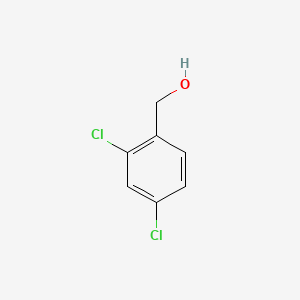



API Suppliers

US DMFs Filed
0

CEP/COS Certifications

JDMFs Filed
0
Other Certificates
Other Suppliers
0

USA (Orange Book)
0

Europe
0

Canada

Australia
0

South Africa
Uploaded Dossiers
U.S. Medicaid
0
Annual Reports
0
0
USFDA Orange Book Patents
0
USFDA Exclusivities
0
Blog #PharmaFlow
0
News
0
EDQM
USP
0
JP
0
Other Listed Suppliers
0
0


1. Dichlorobenzyl Alcohol
1. 1777-82-8
2. (2,4-dichlorophenyl)methanol
3. Dybenal
4. 2,4-dichlorobenzenemethanol
5. Rapidosept
6. Benzenemethanol, 2,4-dichloro-
7. Myacide Sp
8. Benzyl Alcohol, 2,4-dichloro-
9. Chebi:48220
10. Mfcd00004606
11. Nsc-15635
12. 1nkx3648j9
13. Ncgc00181337-01
14. Dsstox_cid_21362
15. Dsstox_rid_79699
16. Dsstox_gsid_41362
17. Cas-1777-82-8
18. 2,4-dichlorobenzylalcohol
19. Einecs 217-210-5
20. Nsc 15635
21. 2,4-dichlorobenzoyl Alcohol
22. Brn 1448652
23. Unii-1nkx3648j9
24. Ai3-20619
25. Schembl41323
26. Oxiconazole Related Compound D
27. Chembl3184437
28. Dtxsid9041362
29. (2,4-dichlorophenyl)methanol #
30. Dalc2-h_000039
31. Zinc157458
32. 2,4-dichlorobenzyl Alcohol, 99%
33. Dichlorobenzyl Alcohol [ii]
34. Dichlorobenzyl Alcohol [mi]
35. Nsc15635
36. Tox21_112796
37. Tox21_300895
38. Bdbm50498198
39. Dichlorobenzyl Alcohol [inci]
40. S6067
41. Stl480884
42. Dichlorobenzyl Alcohol [vandf]
43. Akos000248902
44. Dichlorobenzyl Alcohol [mart.]
45. Tox21_112796_1
46. Am81457
47. Db13269
48. Dichlorobenzyl Alcohol [who-dd]
49. Hy-w039454
50. Ps-5315
51. Ncgc00181337-02
52. Ncgc00181337-03
53. Ncgc00254799-01
54. Ac-10679
55. Sy015811
56. Db-015914
57. Cs-0097299
58. D1837
59. Ft-0610050
60. Ft-0674330
61. 77d828
62. Oxiconazole Related Compound D [usp-rs]
63. 2,4-dichlorobenzyl Alcohol [ep Monograph]
64. Q209202
65. Sr-01000944729
66. Sr-01000944729-1
67. W-107827
68. (2,4-dichlorophenyl)methanol;2,4-dichlorobenzyl Alcohol
69. Z111479786
70. 2,4-dichlorobenzyl Alcohol, European Pharmacopoeia (ep) Reference Standard
| Molecular Weight | 177.02 g/mol |
|---|---|
| Molecular Formula | C7H6Cl2O |
| XLogP3 | 2.5 |
| Hydrogen Bond Donor Count | 1 |
| Hydrogen Bond Acceptor Count | 1 |
| Rotatable Bond Count | 1 |
| Exact Mass | 175.9795702 g/mol |
| Monoisotopic Mass | 175.9795702 g/mol |
| Topological Polar Surface Area | 20.2 Ų |
| Heavy Atom Count | 10 |
| Formal Charge | 0 |
| Complexity | 108 |
| Isotope Atom Count | 0 |
| Defined Atom Stereocenter Count | 0 |
| Undefined Atom Stereocenter Count | 0 |
| Defined Bond Stereocenter Count | 0 |
| Undefined Bond Stereocenter Count | 0 |
| Covalently Bonded Unit Count | 1 |
Dichlorobenzyl alcohol in combination with [DB13908] is available in over-the-counter products used for symptomatic relief of acute sore throat and postoperative sore throat.
In vitro studies with the combination of dichlorobenzyl alcohol and amylmetacresol have shown a virucidal against a number of viruses associated with the common cold which is observed by a reduction in the viral load. In clinical trials, administration of dichlorobenzyl alcohol lozenges has been shown to generate a reduced throat soreness and to provide pain relief and relief from difficulty in swallowing 5 minutes after administration. This effect can last for even 2 hours. The relief effect was shown to reach a steady-state after 45 minutes.
R - Respiratory system
R02 - Throat preparations
R02A - Throat preparations
R02AA - Antiseptics
R02AA03 - Dichlorobenzyl alcohol
Absorption
Dichlorobenzyl alcohol is released almost immediately from its formulation and reaches peak concentration after 3-4 minutes. The concentration in saliva after 120 minutes represents about 50% of the administered dose.
Route of Elimination
In preclinical trials, dermal administration of dichlorobenzyl alcohol results in renal elimination of 90% of the administered dose. After metabolism, dichlorobenzyl alcohol is excreted in the urine.
Volume of Distribution
This pharmacokinetic property has not been fully studied.
Clearance
This pharmacokinetic property has not been fully studied.
Dichlorobenzyl alcohol is metabolized in the liver to form hippuric acid.
This pharmacokinetic property has not been fully studied.
The use of dichlorobenzyl alcohol has been related to its antibacterial, antiviral and local anesthetic properties. The local anesthetic action of dichlorobenzyl alcohol is thought to be due to a reduced sodium channel blockade. The antiseptic mechanism of action of dichlorobenzyl alcohol is not fully understood but it is thought to be related to a denaturation of external proteins and rearrangement of the tertiary structure proteins.


